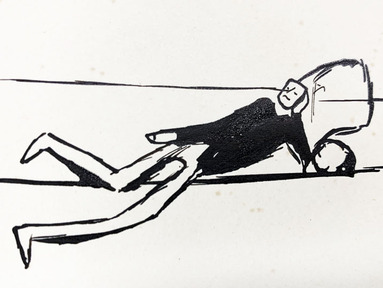On Kafka’s doodles – J.W. McCormack in NYRB:
‘A bearded maestro presides from the back of a business card. A stick figure seems to throttle a mass of squiggles. A harlequin frowns under the chastisement of an irate lump. Two curvilinear ink blots pass each other on a blank-page boulevard. A bushy-browed Captain Haddock-type glowers in profile on a torn envelope and, in the margins of a letter, a wrigglesome delinquent is bisected by a torture device that seems to clearly reference the one from “In the Penal Colony.” Limbs jut out cartoonishly from bodies, loopedy-loop acrobats snake up and down the gutter of a magazine, figures of authority preside in faded pencil, and then there are the stray marks on manuscript pages, neither fully letters nor drawings.’
(…)
‘What a guy, Max Brod. Along with Friedrich Nietzsche’s boon companion Franz Overbeck and Einstein’s patient sounding board at the Bern patent office, Michele Besso, Brod is one of the great second bananas in intellectual history. Famously, Max Brod refused to burn his friend’s unpublished manuscripts upon his death and so gave us one of the most enigmatic repositories of psychological irrealism on file in any language. Kafka made the same request regarding his humble drawings, and this time Brod wisely decided neither to incinerate nor to publish. With the drawings entrusted to Brod, stamped with his imprimatur as executor, and then bequeathed to Hoffe, his mistress, the public might well imagine that they were in store for a visual bonanza comparable to that of Kafka’s prose.’
(…)
‘Kilcher notes that Kafka’s appreciation of visual art consists of a kind of terror of the literal language of drawing, which he considered a threat to the suggestive ambiguity he courted in his prose. In Kilcher’s account, he thought that “the failure of writing is compensated for by the image,” and went to great lengths to avoid having his own books illustrated, writing to one publisher that a certain frontispiece was “too pretty.” But over one hundred years of artists’ renditions have not been sufficient to erode the all-but-unspeakable disquiet at the heart of Kafka, nor are these assorted doodles likely to dislodge the language that still sticks in our throats. In other words, don’t sell yourself short, Franz.’
Read the article here.
How talented Kafka was as a visual artist is of course not the question. As the Israeli artist Roee Rosen stated, rather indirectly but still, in his movie ‘Kafka for Kids’ even Kafka’s shoe is an authority, a master on Kafka, is a piece of art if you will
.
Kafka’s drawings and doodles are intriguing, precisely because any artistic ambition is absent. And they do give us the sensation to be able to come closer, the same way any notebook found in the subway, any doodle left by a stranger on a paper napkin in a bar seems to reveal something important. If we were only interested in the stranger.
As Deleuze and Guattari wrote in their book on Kafka:
‘A writer isn’t a writer-man; he is a machine-man, and an experimental one (who thereby ceases to be a man in order to become an ape or a beetle or a dog, or mouse, a becoming-animal, a becoming inhuman, since it’s actually through voice and through sound and through a style that one becomes an animal, and certainly through the force of sobriety.)
So, you can interpret Kafka’s doodles also as several attempts to become another animal. And don’t most of us dream of becoming another animal?
